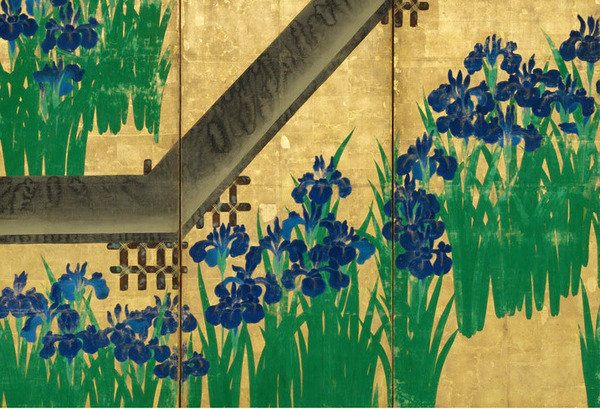Designing Nature
dal 9/9/2012 al 12/1/2013
Segnalato da
9/9/2012
Designing Nature
Metropolitan Museum of Art - MET, New York
The Rinpa Aesthetic in Japanese Art. Rinpa is a modern term that refers to a distinctive style of Japanese pictorial and applied arts that arose in the early 17th century and has continued into modern times. The exhibition will trace the development of the Rinpa style and demonstrate how it continued to influence artists through the 19th and 20th centuries.

Rinpa is a modern term that refers to a distinctive style of Japanese pictorial and applied arts that arose in the early 17th century and has continued into modern times. Literally meaning “school of Korin,” Rinpa derives its name from that of the renowned artist Ogata Korin (1658–1716). It embraces art marked by a bold, graphic abbreviation of natural motifs, frequent reference to traditional court literature and poetry, lavish use of expensive mineral and metallic pigments, incorporation of calligraphy into painting compositions, and innovative experimentation with brush techniques.
The exhibition is made possible by The Miriam and Ira D. Wallach Foundation.
A special exhibition featuring some 90 brilliantly executed works of art created in Japan by Rinpa-school artists will be held at The Metropolitan Museum of Art in two rotations; the first opening on May 26 and the second on September 12, 2012. Highlighting the school’s most prominent proponents, Designing Nature: The Rinpa Aesthetic in Japanese Art will trace the development of the Rinpa style and demonstrate how it continued to influence artists through the 19th and 20th centuries. Comprising some 50 works from the Museum’s own holdings, as well as some 45 loans from public and private collections on the East Coast, the exhibition will include many masters’ renowned works in a variety of media―painting, textiles, lacquerware, and ceramics.
Works on view in the exhibition’s first rotation will include: an early 18th-century, two-panel folding screen, Rough Waves, by Ogata Korin, depicting highly stylized waves; another 18th-century, two-panel folding screen, The Persimmon Tree, by Sakai Hoitsu, the founder of the Edo branch of Rinpa, revealing the ink-painting techniques he learned from predecessors such as Tawaraya Sotatsu; and a 19th-century pair of six-panel folding screens, Morning Glories by Suzuki Kiitsu, who was Hoitsu’s primary pupil and who captured the exuberant proliferation of the blossoms and leaves.
A centerpiece of the exhibition’s second rotation will be the famous Korin Irises at Yatsuhashi (Eight Bridges), with its brilliant array of clusters of purple irises against a gold background. A hanging scroll by Kenzan, Korin’s younger brother, captures an autumnal mood through a depiction of vivid red ivy and a poem rendered in the artist’s distinctive calligraphy. An early 17th-century screen of calligraphy by Konoe Nobutada features transcriptions by female poets of the Heian court; on loan from Yale University Art Museum, it will be on public display for the first time.
Along with once-in-a-lifetime displays of masterpieces of painting and calligraphy, the exhibition will highlight rare illustrated books, lacquerware, ceramics, cloissoné, and kimono that demonstrate how the Rinpa aesthetic was transmitted over generations into modern times. Special digital displays of illustrated books by Kamisaka Sekka will be available in the galleries so that visitors can “turn the pages” of early 20th-century books that will be exhibited in cases nearby.
By the late 19th century, the idea of a Rinpa school had become firmly established, both in the Japanese consciousness of a national history of art and internationally. To a certain extent, Rinpa became synonymous with the very idea of Japanese art, since its aesthetic extended to the lacquerware, textiles, and ceramics that were transmitted to the West. Prominent among the artists of the modern age who exemplified the transmission of this Kyoto-based aesthetic into the modern consciousness were Shibata Zeshin, a lacquer artist and painter, and Kamisaka Sekka, who excelled in both painting and print media.
The exhibition will be accompanied by a catalogue.
The catalogue is made possible by the Richard and Geneva Hofheimer Memorial Fund.
In conjunction with the exhibition, the Museum offers various education programs, including gallery talks and a Sunday at the Met on September 30.
Designing Nature: The Rinpa Aesthetic in Japanese Art is organized by John T. Carpenter, Curator of Japanese Art in the Department of Asian Art at The Metropolitan Museum of Art.
The exhibition will be featured on the Museum’s website at www.metmuseum.org.
Press requests for information, images, and interview opportunities can be directed to the Communications Department: Phone: (212) 570-3951 Fax: (212) 472-2764 Email: communications@metmuseum.org
Press viewing: Monday, September 10, 10 a.m. - noon
The Sackler Wing Galleries for the Arts of Japan, second floor
Metropolitan Museum of Art MET
1000 Fifth Avenue at 82nd Street New York
Hours
Tuesday–Thursday: 9:30 a.m.–5:30 p.m.
Friday and Saturday: 9:30 a.m.–9:00 p.m.
Sunday: 9:30 a.m.–5:30 p.m.
Galleries are cleared fifteen minutes before closing.
Closed Monday (except Met Holiday Mondays)
Saturday Evenings are made possible by the William H. Kearns Foundation.
Admission
Adults $25
Seniors (65 and older) $17
Students $12*
Members (Join Now) Free
Children under 12 (accompanied by an adult)



